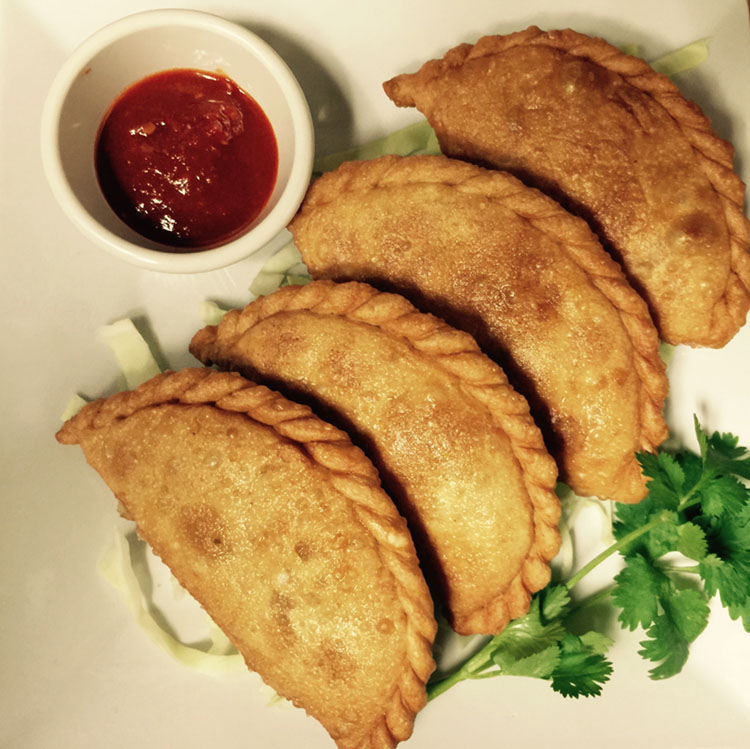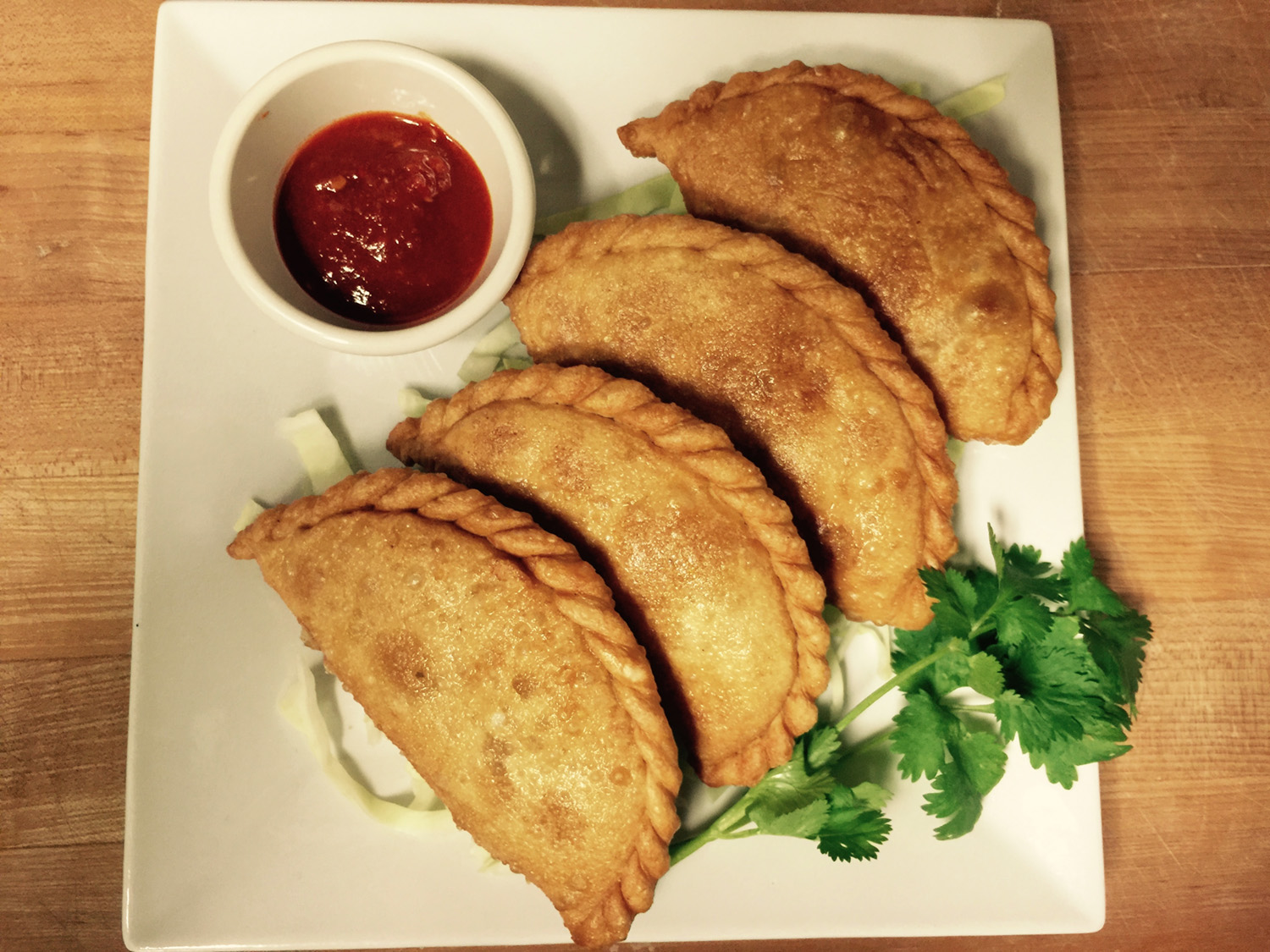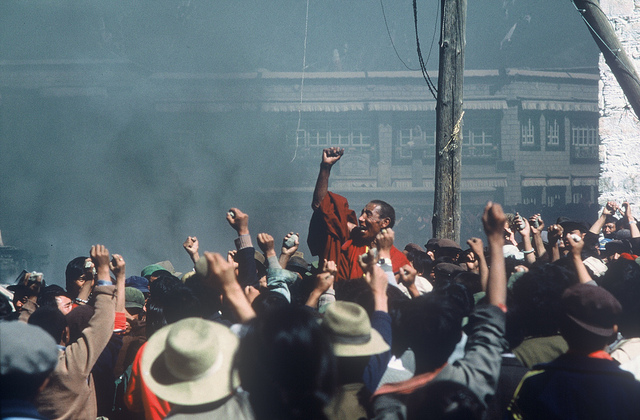We were having dinner at the very cosy Little Tibet Restaurant at Jackson Heights last month. Someone insisted I try a Shabhalay from a plate he had ordered. It’s not my favorite food. The shabhalays I had eaten before had largely been products of institution kitchens (chi-thab): too oily, the dough wrap too leathery, stuffing too full of onions too little meat, even the braiding (Tib: sul) around the side often being rock hard. But the confection I bit into that evening at Little Tibet was absolutely something else. It was deep-fried but not greasy, the dough wrapping soft and succulent, the stuffing meaty and juicy. The edges were slightly crisp but soft and tasty.
Some days later someone gave me a take-out shabhalay from Friends Corner (also at Jackson Heights) which was equally delicious. And why shouldn’t they be? Properly done the shabhalay belongs to a great tradition of stuffed bread pastries from around the world, among the more well-known being the Spanish empanada, the Italian calzone, the Cornish pasty, and the Mongol Khuushuur which is stuffed with mutton. But generally they are filled with beef, cheese, ham or combinations of one or the other. They all look pretty much the same though.
Most of these are baked but and there is a deep-fried version of the calzone called the panzerotte. The Dutch kaassouffléis also fried in oil, while the Khuushuur is deep-fried in mutton fat.
Tibetans make a “Sokpo (Mongol) Shabhalay” which is nothing like the Khuushuur, but is lip-smackingly delicious. The unique thing about this shabhalay is its two-stage frying. For details check the excellent recipe on the website Simply Tibetan, Simply Delicious.
During the 1987-1989 Lhasa uprisings, the inoffensive shabhalay, took on a what might be described as a subversive even revolutionary overtone. Earlier, the only connection shabhalay had to anything remotely forceful was the Tibetan expression “a shabhalay on the butt” (kup la shabhalay), which is a jokey way of telling kids you’ll whack them. A Tibetan rapper in Swizerland picking of on this reference has called himself “Shabhalay” and made a few music videos for educating young people.
But as the uprisings in Lhasa continued and the prisons in and around the city filled up with many hundreds of arrested demonstrators, the parents, relatives and friends of these prisoners had to bring them food from the outside. Prison rations in Tibet and China are essentially designed to starve the inmate slowly into ideological submission, many dying of malnutrition or disease before that. One arrested demonstrator (who I later met in Dharamshala) noticed that the overwhelming number of visitors brought shabhalays for the prisoners. He figured that the shabhalay had a number of virtues that made it the ideal prison food. The dough wrap provided the carbohydrate, the meat-filling the necessary protein, and the frying in oil or butter, the vital fat content you needed to stay alive in the cold of Tibetan prisons (especially Sangyip which is sub-artic all year round). The shabhalay was also convenient for both the delivery person and the prisoner. You didn’t need dishes or spoons or knives. You just held it in your hand a like sandwich or a calzone and ate it warm or cold, standing up, or walking in a prison line.
Because there were so many shabhalays circulating in the prisons, prisoners passed them on to each other, sometimes even to a guard. It was so ubiquitous it jokingly began to be called rangzen-bhaley, or independence bread. The occupation authorities immediately imposed a total ban on the bringing of shabhalays to prison, and even a ban on making or selling it in the city. I don’t know how long the ban was enforced but I am sure that it was effective for the period. I am also sure that the authorities were deadly serious when they made their proclamation. Even a mention of shabhalay might get you hauled up for an interview at the police station.
A wise China scholar (who shall remain nameless) once told me, without a trace of sarcasm, that the fundamental operating ideology of the PRC was institutionalized paranoia.







A tasty piece !
shapalay comes in different forms. the one I grew up with and much more traditional, is the plain round ones stuffed with meat. the ones in the picture are closer to the one’s Mongolians make called hurshuur.
Never liked Shabhalay for some reason but I have a feeling the root cause could probably be traced back to a traumatic childhood experience of eating cardboard textured Shabhalays. Anyway, enjoyed the article. By the by, since we have co-opted the Tsampa and now Shabhalay as symbol of nationalism, is there any plans for Momos?
Thank you this is interesting to read, It brought me back some of my childhood memories like our math teacher used to say ” if you don’t complete your homework, i would give you shabhalay”
what about TSAMPA? Tsampa eaters as we always call ourself. it could be another interesting privilege to read if you could write on Tsampa.
#yakboy59
Jamyang Norbu la, what a delicious piece — food for thought. You could write a whole book about food for/and politics…I once had the luck to be given a jar of fried pork, little fish, chilly and black beans from two visiting Burmese women activists (a Rohingya and a Kachin), and was told it was a prisoners’ dish because it has all the nutrients and it can keep for a long time without refrigeration in a tropical climate. So the spicy fried mixture has been the most popular dish sent in to the prisoners by their friends or relatives.
Thank you Jamyang la. I enjoyed reading it very much. Another reader suggested writing about tsampa. If I am not mistaken I think I remember reading about tsampa here a while ago including the method of making a paak (tsampa touch made with butter tea).You can order organic tsampa from my website. Tibetans and supporters may or may not get a discount.
https://www.jamyangnorbu.com/blog/2011/02/07/in-defence-of-tibetan-cooking-part-i/
I enjoyed the article about shabalay. I hope some good cook comes up with veg stuffed bhalay because there are some of us who don’t like meat. Don’t judge. I am neither a hippy nor a “ooey gooey dharma type.” Just little bit defensive for constantly being labelled as sotoekampo and grass eater. To each his own or as the french say, excuse the Tibfrench spelling, shaka songoo (to each his own).
One of my cats jumped on my keyboard and deleted rest of the post which said something illunimating about shabalay and Tibetanness. What’s more it spilled my daily metamucil and prune juice cocktail. I am besides myself with excitement and in no position to type anything fit for kid’s ears today.
Sorry to post something not related to shabalay. But I think someone who reads this blog will be able to get my point. I was walking along trail with Sindu. Someone came up to me and asked me if he was an apso. I said Yes. Then I was asked if I was a Tibetan. Buddhist. I said Yes and yes. Then I was asked if I meditate. I said no. And I said majority of the Tibetan monks and lamas hardly ever meditate. Am I correct in telling her that most monks and lamas meditate around westerners only because it is expected of them? And of course for livelihood.
First of I commend Jamyang la on yet another enlightening article.
This is a response to “Grumpy Ol Woman” – if you are referring to Meditation in the tradition form, sitting in a lotus position and all the rest then, most Tibetans I know don’t.
However, most Tibetans I know have an Altar of some sorts with their personal deities and lama in a little corner of their homes and offer incense and Yon-chap every morning and during that brief moment they do meditate in their own way. This is not a modern practice but an age old tradition and certainly a meditation of sorts as we pray for all sentient beings.
Thank you Gyalpot. I know what you mean since we have too have an altar in our own home. That is more like offering and reciting mantra and praying for a few minutes. I mean the extended meditation of hours. But thank you for your answer.
sorry jamyang la…. i wud like to share a bits of feelings from the view of my friends who have come from tibet as a child and now after college finding themselves no belonging to any tibetan society….
Stateless Refugee: The Leftovers
Home away from home
Is what most Tibetan’s feel
Fled their homes to seek better life
Resettling in different settlement
Refugee life started with a peice of land
Along came the young childrens
With their life’s trusted on the passing strangers
Flocking the refugee schools in exile not knowing
What their future holds for them.
By enduring the endless journey
with their young legs trailing behind the smugglers
Not knowing that some would never see their families again
School life is fun but not always when you have no one
To scream to, cry, nag on and hug as your friends do
Watching your mates being taken for long winter holiday
And the frequent visit of parents with gifts and momo’s
Only fuels up the anger of being disowned and leftout
Days turned into months and then years…
Question of where to go after 12th exam drew nearer
Clinking together gets you past the college,
Everyone goes home eventually but what about Them, The leftovers
Who do not have place called home and
A refugee who doesn’t belong to any settlements
With no postal address for Identity certificate or any Docs.
A stateless refugee with only RC book to certify it
Where do they belong? Newly arrived or the settled ones
Are they the forgotten ones or the negleted ones.
Not even considered for the resettlement in refugee camps.
A homeless refugee is the plight of these students
Wondering when their endless journey of backpacking would end
From a home they had never seen since
To a home that never belong to them, A stateless refugee is who they are.
“In politics nobody owns me and I don’t owe anybody anything, except for the promise that I will work for the well-being of all Americans, especially those who otherwise would have no voice in the corridors of power.”
The above statement is from former democratic senator who is exploring to run for Democratic presidential candadite.
My million dollar question is : Can Sikyong Lobsang -always-on-tour-Sangay at the cost of public fund say the same thing?
Who paid his mortgage on his duplex in posh Boston city and what he owes in return?
Dicky Choyang is a good politician but not fit to be a Prime Minister. She is not courageous enough and will bend to the wishes of those invisible puppeteers in the background. The present one has been dancing too well to those tunes of those puppet masters right now. She has done nothing but toe the line so far. We need someone with substance to run for Prime Minister, not some wanna be celebrity who thinks the size of his motorcade is more important than meeting ad understanding the hearts and minds of his people for real.
Did you not read what Dhasa Yogi wrote about Dicki Choyang being watched by what Jamyang Nobru calls the David Axelrod of Sikyong , Kaydor Aukatsang. So yes , Dicki Choyang doesnot stand a chance if it is true . This man scares me more than any other Tibetan man. He’s very quiet but everyone knows he’s sikyongs brain. Sikyong is that very feminine , outspoken and chatty and outgoing personality but his strategist is his best buddy Aukatsang . Sikyong would be decapitated without him. Anyways , those of you who are opting for Dickyi Choyang for the 2016 elections can maybe get the name of all the mistresses and pictures of Sikyong and his buddies mistresses in Dhasa and around the globe and publish them. And then maybe she might stand a chance at beating Sikyong by assassinating all their characters but other than that sorry ….. Sikyong is going to win again and Aukatsang is in the post for next 4 years . The tricky birds catch the world 🙂
Is something cooking in RAF Tibetan Service? My sources told me that it is good bye freedom of press and bring 500 momos. what is really happening ?
Radio Free Asia Tibetan website is like our exile govt.media. I am just sad to see there a not whole lot of inside Tibetan news and issue now. May be because of leadership change everything has fallen apart.
No more bashing to Xinhua from my side now.It is already happpening in my plate.
Bye bye Radio Free Asia. Thank you Khabdha and Tibettimes. There r more tibet news.
Jamyang la, thank you for inadvertently great review of Little Tibet’s Shabhaley. It was never in our wildest imagination that we were serving something truly revolutionary. Thank you for always teaching us more. And your constant feedback about recipes we should incorporate in our menu always inspires us to do better and be proud of ourselves that we are making our meager contribution for the resistance.